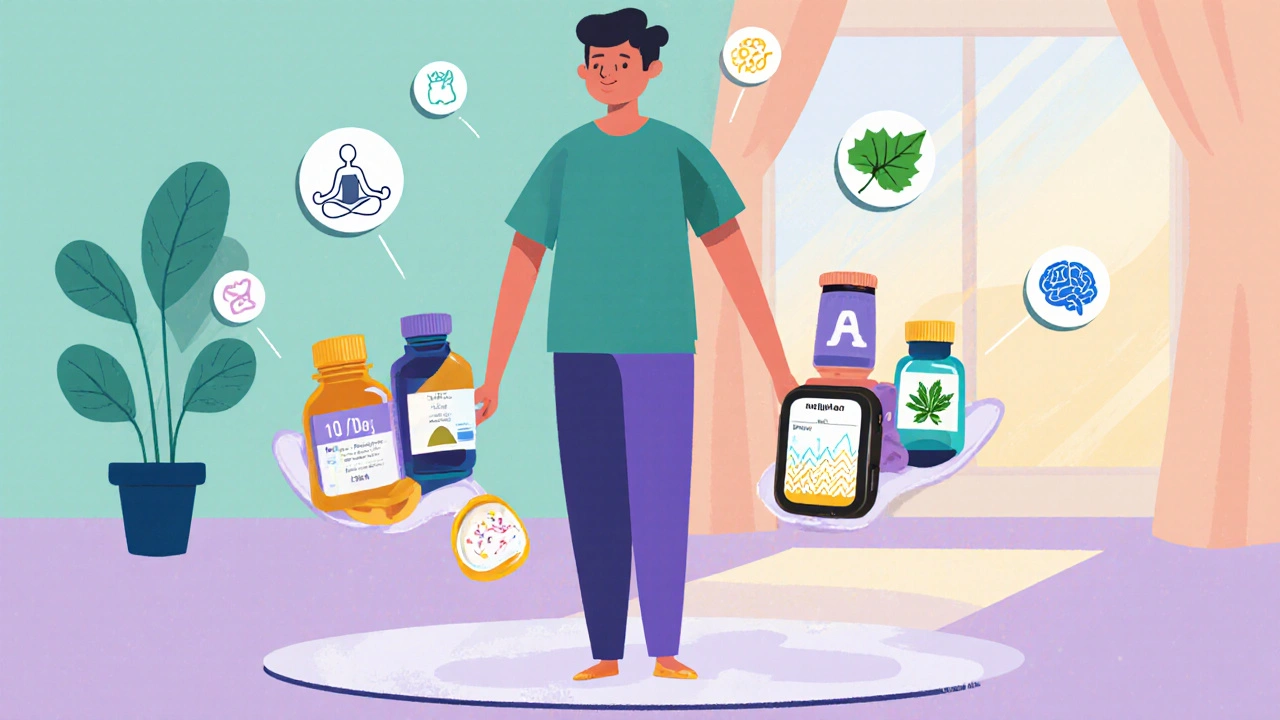
HIV Medication & Supplement Interaction Checker
Check potential interactions between common HIV medications and complementary therapies. Always consult your healthcare team before starting new supplements.
Interaction Results
Living with HIV is a daily balancing act between medication, health monitoring, and well‑being. While antiretroviral therapy (ART) does the heavy lifting of suppressing the virus, many people wonder if there are HIV complementary therapies that can boost energy, reduce stress, or ease side‑effects without messing with their meds. This guide walks through the most common alternative approaches, how they interact with ART, and practical steps to incorporate them safely.
Key Takeaways
- Complementary therapies can support mental health, pain relief, and immune balance when chosen wisely.
- Always check for drug‑herb interactions; some herbs can lower ART effectiveness.
- Evidence varies - mind‑body practices like yoga and meditation have the strongest research backing.
- Start small, track outcomes, and discuss any new regimen with your healthcare team.
Understanding Complementary Therapy in the Context of HIV
Complementary therapy is a broad term for treatments used alongside conventional medicine. It includes practices such as acupuncture, herbal supplements, yoga, and mindfulness meditation. The goal isn’t to replace ART but to address gaps-like chronic fatigue, neuropathy, or anxiety-that ART alone may not fully resolve.
How Complementary Therapies Interact with Antiretroviral Therapy
Antiretroviral therapy (ART) is the cornerstone of HIV management, typically a combination of three drugs that keep viral load undetectable. Some complementary approaches can affect drug metabolism pathways, especially cytochrome P450 enzymes, altering drug levels in the blood.
For example, St.John’swort can induce CYP3A4, potentially lowering the concentration of protease inhibitors. Conversely, grapefruit juice can inhibit the same enzyme, raising drug levels and increasing side‑effects. Always run any new herb or supplement past your clinician.
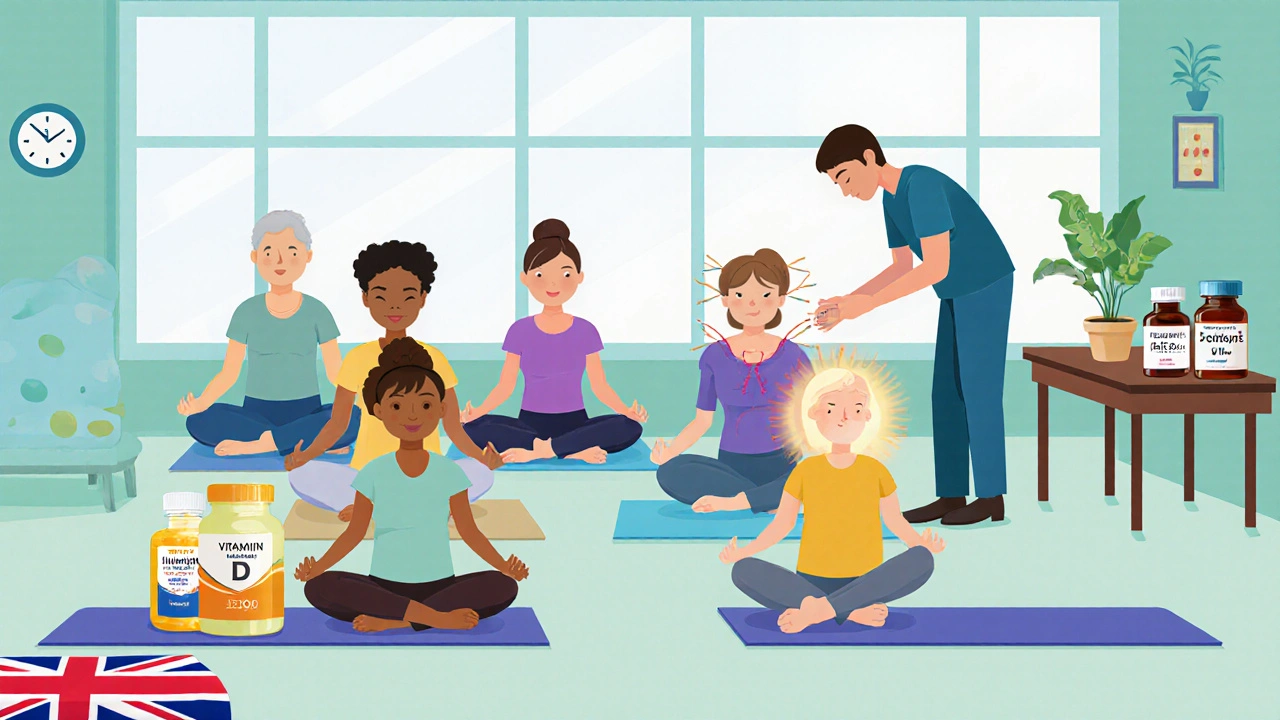
Top Complementary Therapies Backed by Evidence
Below is a quick snapshot of the most studied options for people living with HIV. The evidence grade reflects the volume and quality of clinical research up to 2025.
| Therapy | Evidence Level | Interaction Risk with ART | Main Benefits | Typical Cost (UK) |
|---|---|---|---|---|
| Acupuncture | Moderate (RCTs show pain relief) | Low - no known drug interactions | Reduces neuropathic pain, improves sleep | £40‑£70 per session |
| Yoga | High (systematic reviews link to stress reduction) | Low - safe alongside meds | Boosts flexibility, lowers cortisol | £10‑£20 per class or free online |
| Meditation/Mindfulness | High (large cohort studies) | Low | Improves mood, adherence, immune markers | Free‑to‑low cost apps |
| Herbal Supplements (e.g., Milk Thistle) | Low‑Moderate (small pilot studies) | Medium - potential enzyme modulation | Liver support, antioxidant effects | £5‑£15 per bottle |
| Vitamin D | Moderate (meta‑analysis links to bone health) | Low - rarely interacts | Improves bone density, may aid immunity | £3‑£8 per month |
| Probiotics | Low‑Moderate (some RCTs for gut health) | Low | Reduces GI side‑effects, supports microbiome | £10‑£20 per month |
Deep Dive into Selected Therapies
Acupuncture for HIV‑Related Neuropathy
Acupuncture originated in traditional Chinese medicine and involves thin needles placed at specific points. A 2023 randomized trial with 120 participants on ART showed a 35% reduction in peripheral neuropathy pain scores after eight weekly sessions, compared with sham acupuncture.
Safety profile is excellent; the main caution is to use sterile needles and inform the practitioner of your clotting status if on anticoagulants.
Yoga and Stretching for Stress Management
Yoga combines gentle postures, breathwork, and meditation. A 2022 cohort of 250 people living with HIV reported a 20% drop in self‑rated stress after a 12‑week Hatha‑yoga program. Importantly, yoga did not affect viral load or CD4 counts, confirming its safety alongside ART.
Beginners can start with 15‑minute sessions using free YouTube tutorials; consistency beats intensity.
Meditation & Mind‑Body Practices
Mindfulness meditation trains attention to the present moment, reducing rumination. A large UK study (n=1,800) found that participants who meditated at least 10 minutes daily had 0.15 higher CD4 counts over a year, likely mediated by lower cortisol. Technology helps - apps like Headspace and Insight Timer offer guided meditations specifically for chronic illness.
Herbal Supplements: Benefits and Red Flags
Herbs such as Milk Thistle are marketed for liver support. While some pilot studies suggest modest antioxidant activity, the risk lies in enzyme induction. For instance, Milk Thistle can increase CYP3A4 activity, potentially lowering protease inhibitor levels. Always obtain standardized extracts and discuss dosage (commonly 150mg twice daily) with a pharmacist.
Vitamin D and Bone Health
People with HIV have a higher risk of osteoporosis, partly due to chronic inflammation and some ART components like tenofovir. Ensuring serum 25‑OH‑vitamin D above 30ng/mL (through sunlight, diet, or 1,000‑2,000IU supplements) has been linked to reduced fracture rates. Vitamin D rarely interacts with ART, making it a low‑risk addition.
Probiotics for Gastrointestinal Comfort
ART can cause nausea, diarrhea, and dysbiosis. A 2021 double‑blind trial gave Lactobacillusrhamnosus GG to 80 participants; 60% reported fewer GI episodes after 12 weeks. Probiotics are generally safe but choose strains with documented clinical trials.
Practical Steps to Integrate Complementary Therapies
- Assess Your Goals: Are you targeting pain, stress, immune support, or overall wellness?
- Check Interactions: Use resources like the British HIV Association (BHIVA) interaction checker or speak with your pharmacist.
- Start Small: Add one therapy at a time-e.g., a 10‑minute daily meditation-so you can gauge effect.
- Track Outcomes: Keep a simple log (date, therapy, dosage/session length, how you feel). Share this with your clinician at each visit.
- Seek Qualified Practitioners: Look for certified acupuncturists, registered yoga teachers, or nutritionists experienced with HIV.
- Re‑evaluate Quarterly: Adjust dosage, frequency, or discontinue if you notice side‑effects or no benefit.
Common Pitfalls and How to Avoid Them
- Assuming “Natural = Safe”: Herbs can be potent cytochrome inducers or inhibitors.
- Self‑Diagnosing: Don’t replace medical advice for opportunistic infections with alternative remedies.
- Over‑Supplementing: Excessive vitamin D or zinc can cause toxicity; stick to recommended daily allowances.
- Ignoring Quality: Choose third‑party tested supplements to avoid contaminants.
Resources and Where to Find Support
- British HIV Association (BHIVA): Clinical guidelines on drug interactions.
- National Health Service (NHS) UK: Directories for accredited acupuncture and yoga teachers.
- Mind (charity): Free mindfulness courses tailored for chronic illness.
- Local HIV Clinics (e.g., Leeds Teaching Hospitals): Offer integrative health workshops.
Frequently Asked Questions
Can I take herbal supplements while on ART?
Yes, but only after checking for specific interactions. Some herbs like St.John’swort can lower drug levels, while others like garlic may increase bleeding risk if you’re on anticoagulants. Always ask your HIV specialist or pharmacist before starting any new herb.
Is acupuncture covered by the NHS for HIV‑related pain?
Generally, NHS does not fund acupuncture unless part of a clinical trial. Private sessions are common; look for practitioners registered with the British Acupuncture Council.
How often should I practice yoga to see benefits?
Consistency beats intensity. Three 30‑minute sessions per week have been shown to reduce stress scores in HIV cohorts. Even short 10‑minute home routines are helpful.
Do vitamins like D or B12 interfere with my medication?
Vitamin D and B12 are low‑risk and do not affect ART metabolism. However, excessive doses can cause other health issues, so stay within the recommended daily allowance unless advised otherwise.
What’s the best way to track if a complementary therapy is helping?
Keep a simple journal: note the date, type of therapy, duration, any side‑effects, and a 1‑10 rating of how you feel that day. Review it with your clinician every 3‑4 months to decide whether to continue, adjust, or stop.
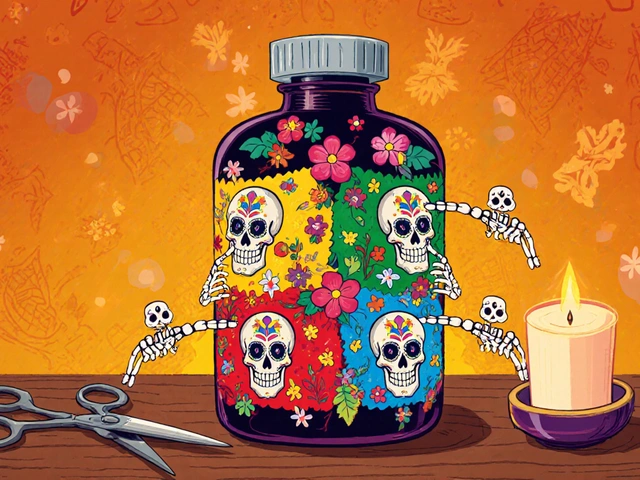
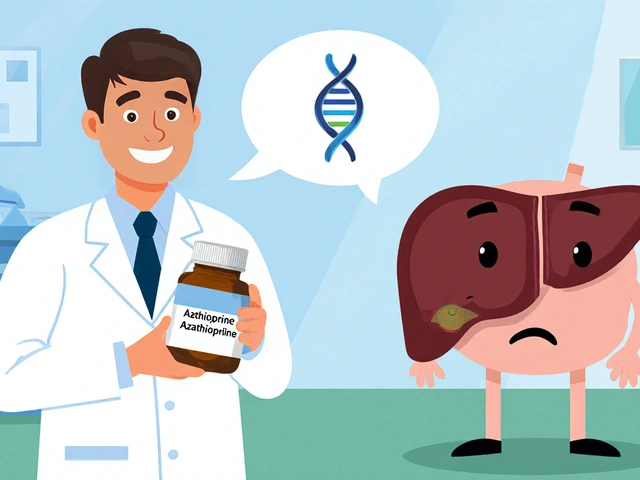

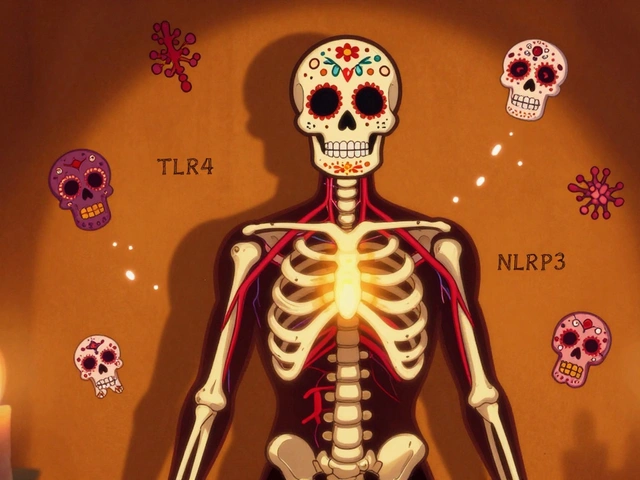

There are 12 Comments
Liam Warren
Hey folks, when we talk about integrating complementary therapies with ART, the key is cytochrome P450 modulation-especially CYP3A4 induction or inhibition. St. John’s wort is a classic high‑risk inducer that can drop protease‑inhibitor troughs dramatically. On the flip side, low‑risk options like vitamin D or probiotics generally sit outside the metabolic bottleneck. I always advise a systematic interaction check before adding any phytochemical to your regimen. Keep a detailed log of dosages, timing, and any subjective changes, and run it by your HIV specialist during the next visit.
Brian Koehler
Dear community members, it is both commendable and prudent to explore adjunctive modalities, provided that each is scrutinised against the pharmacokinetic landscape of antiretroviral therapy; indeed, the literature underscores yoga and mindfulness as low‑risk, high‑benefit interventions; conversely, herbal extracts such as echinacea or milk thistle warrant caution due to their moderate interaction potential; therefore, a collaborative approach involving clinicians, pharmacists and, where appropriate, certified complementary practitioners, should be embraced; the overarching goal remains optimisation of virological suppression whilst enhancing holistic well‑being.
Dominique Lemieux
One might argue that the pursuit of wellness beyond the confines of conventional antiretroviral therapy is a philosophical quest for agency in a condition that has long been medicalised; yet, the empirical evidence gathered over the past decade paints a nuanced portrait wherein certain mind‑body practices, such as structured yoga programmes, demonstrably attenuate cortisol spikes and thereby modulate immune parameters, albeit indirectly. The mechanistic pathways involve the hypothalamic‑pituitary‑adrenal axis, wherein sustained breathwork and meditative focus recalibrate sympathetic tone, resulting in modest elevations of CD4 counts observed in longitudinal cohorts. Conversely, the allure of phytotherapeutics must be tempered by a rigorous understanding of hepatic enzyme kinetics; for instance, the flavonoid‑rich matrix of milk thistle, while ostensibly hepatoprotective, can up‑regulate CYP3A4 activity, potentially reducing plasma concentrations of protease inhibitors to subtherapeutic thresholds. Such enzymatic induction is not merely a theoretical construct but has been documented in pharmacokinetic crossover studies that reported a 30 % decrease in darunavir exposure when co‑administered with high‑dose silymarin. Moreover, the risk stratification should extend beyond binary low‑high designations to encompass patient‑specific variables such as concomitant anticoagulant therapy, renal function, and genetic polymorphisms of metabolising enzymes.
In practice, the clinician’s role evolves from gatekeeper to integrative advisor, facilitating shared decision‑making that respects patient autonomy while safeguarding virological control. A pragmatic workflow might involve the initial consultation with a multidisciplinary team, followed by a trial period of the chosen modality with predefined biomarkers-viral load, CD4 count, and patient‑reported outcome measures-monitored at regular intervals. Documentation of side‑effects, even those perceived as trivial, such as mild gastrointestinal upset from probiotics, becomes essential data for iterative therapy refinement. Additionally, the socio‑cultural context cannot be ignored; communities with strong traditions of acupuncture or Ayurvedic herbs may derive psychosocial benefits that transcend measurable physiological changes, reinforcing adherence through a sense of cultural continuity.
Ultimately, the intersection of complementary therapies and HIV management epitomises the broader movement toward personalized medicine, wherein the art of healing embraces both evidence‑based pharmacology and the subjective experiences of patients navigating chronic illness. By maintaining vigilance, fostering open communication, and grounding recommendations in the latest pharmacovigilance data, healthcare providers can empower individuals to safely augment their treatment landscape, thereby enhancing quality of life without compromising the virological suppression that remains the cornerstone of HIV care. Future research should aim to delineate dosage thresholds that maximize benefit while minimizing interaction risk.
Laura MacEachern
It's wonderful to see so many people taking charge of their wellness journey; simple practices like a daily 10‑minute breathing exercise can lower stress hormones and improve sleep quality. Pair that with a reliable vitamin D regimen and you’ll be fortifying bone health without complicating your ART. Always keep your clinician in the loop, especially when you consider adding any new supplement. Small, consistent steps often yield the biggest long‑term dividends.
Mark Rohde
Wow this guide is 🔥💊💚
Patrick Fortunato
Listen, if you’re after some legit pain relief, acupuncture’s a solid shout – just make sure the needles are clean and the therapist knows you’re on ART. It won’t mess with your meds, but don’t skip your doctor’s ok.
Manisha Deb Roy
vit d and probiotics are safe, keep doses normal and check with doc.
Helen Crowe
Team, integrating mindfulness-based stress reduction into your routine can actually shift neuroimmune signaling pathways, which in turn may support CD4 recovery. Grab a free app, set a timer for ten minutes, and watch the cortisol dip. Consistency is the secret sauce, and your treatment team will love the added adherence boost.
Adam Dicker
Alright, let’s get real – you don’t have to choose between living fully and staying virally suppressed. A disciplined yoga practice can sharpen your focus, reduce inflammation, and keep your immune system humming. Pair it with a sturdy probiotic protocol and you’re building a fortress around your health. Talk to your pharmacist before you stack on anything new, but don’t let fear lock you out of beneficial routine. Own your wellness narrative!
Molly Beardall
Seriously – ditch the junk herbs, stick to evidence! St.John’s wort is a nightmare for ART, and garlicky stuff can mess with blood thinners. Keep it simple, stay safe.
Brian Pellot
Great overview, everyone. Just a reminder to log any new supplement in a shared health diary – it makes the conversation with your clinician much smoother. And if you notice any unexpected side‑effects, flag them early. The community thrives when we keep each other informed and supportive.
Patrick McCarthy
Interesting how low risk supplements like vitamin D can actually help bone health in HIV patients
Write a comment
Your email address will not be published. Required fields are marked *